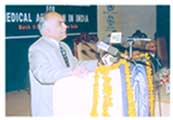 |

Maternal
death, due to abortions has always been a horrendous public health problem.
Almost 453 women per hundred thousand die due to maternal causes. Deaths
from abortion account for 12-18% of all maternal deaths. After abortion,
it is not only the death from abortion which is a casue of concern,
but also a tremendous amount of morbidity. In an ICMR study, it was
observed that around 19 per 1000 women undergo abortion, out of which
only 6 are legal abortions while the rest 13 are illegal abortions.
It was also observed that, during her reproductive lifespan a women
undergoes abortion 1-2.5 times. With this kind of dimension, it is very
essential to protect women from morbidity and mortality of abortion.
The whole family suffers and gets ruined due to death of woman in the
family.
In every culture, people face unwanted pregancies
which they do not want to continue. The Indian figures showed that 5
million abortions took place in one of the surveys, out of which 4.5
million were unsafe. Most figures are extrapolated as actual figures
are not available. A major policy is needed for healthcare facility
to provide abortion services. Only one-third to one-fourth of existing
facilities have infrastructure to provide abortion services. Even in
these facilities, the sensitivity is lacking in providing abortion services.
In an ICMR study (published in Contraception,
2000) mifepristone was used with 9-methlylene PGE2 gel (meteneprost)
and oral PGE1 (misoprostol). The results indicated a success rate of
84% and 87% respectively. Around 5-15% women needed back-up facilities.
Thus, we should also provide back-up and counseling services. It was
very enlightening that, in the rural set-up also, this particular medication
showed good results in ICMR study. However, in our country, we need
to look up at the rural set-up and the delivery system very closely.
ICMR has initiated a new study in 20 district
level centres to look at the delivery-associated problems. Another problem
that needs a clear-cut direction is the cut-off gestational age to administer
this medication. A number of studies have been performed at different
gestational ages from as early as 28 days up to 63 days of amenorrhoea.
We should remove this ambiguity. Medical abortion set-up needs to go
to grassroot level. The feasibility of home administration of the second
drug (misoprostol) is under trial with good back-up facilities. We must
involve social scientists, community and behavioural scientists. Many
a time, woman is not the decision-maker. We must see that medical abortion
is not misused. I wish this particular congress all success and we would
be eagerly waiting for the outcome from your deliberations. |
 |

|